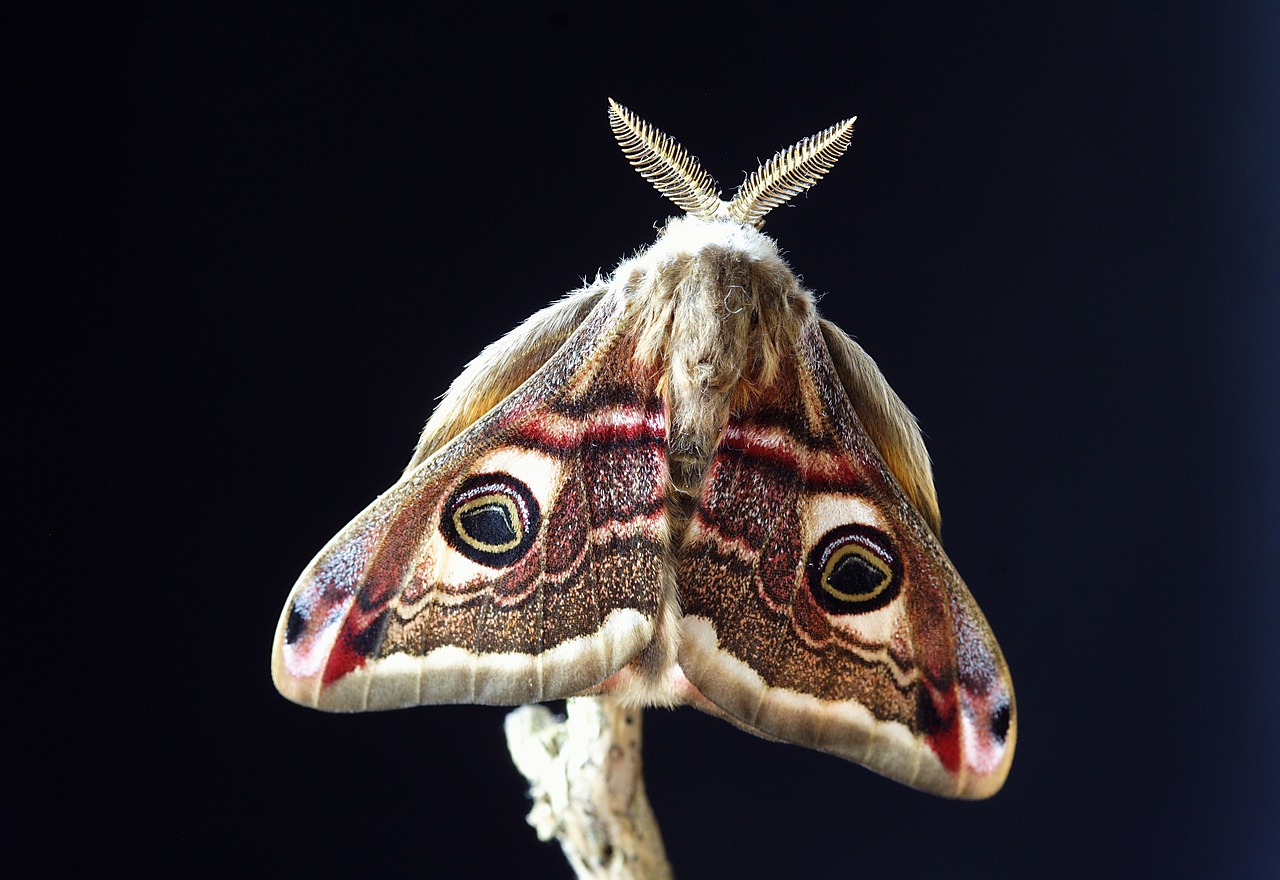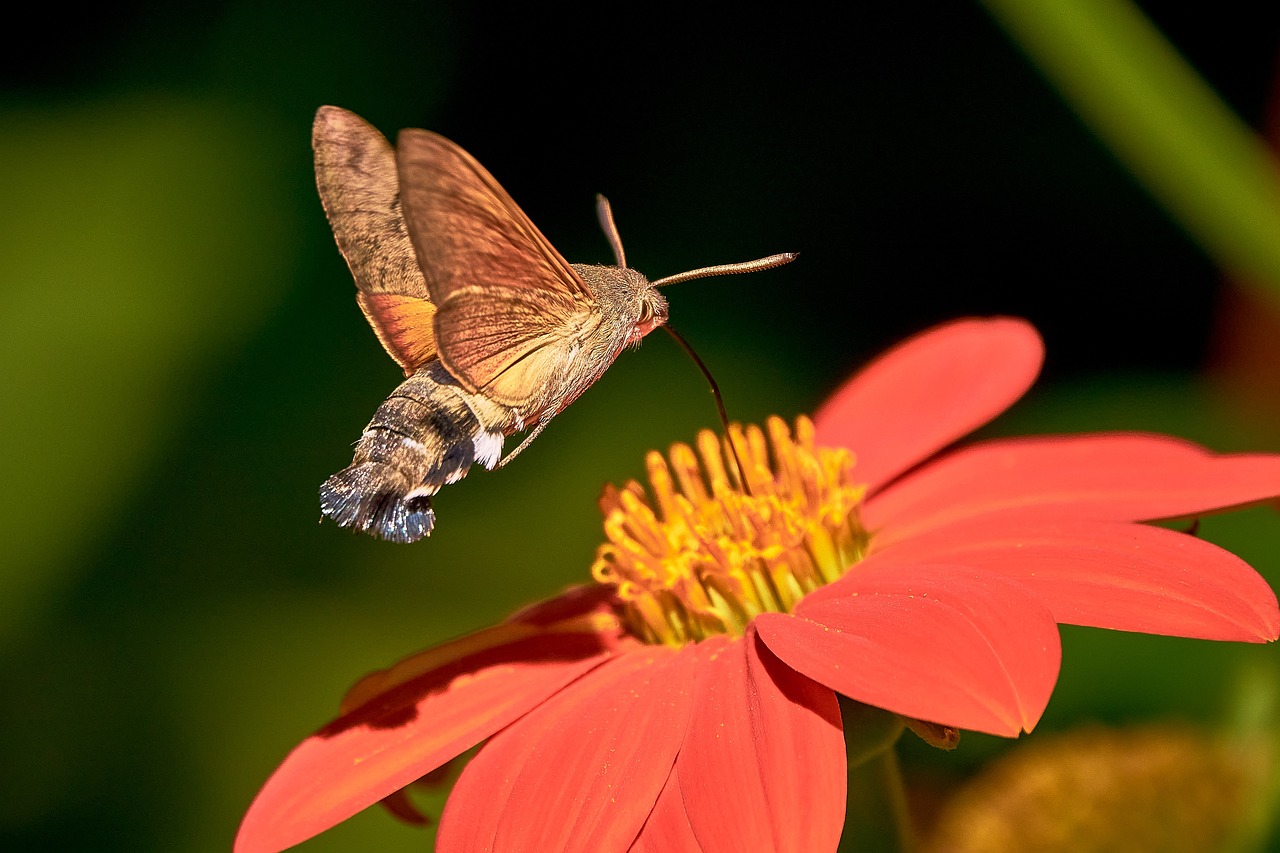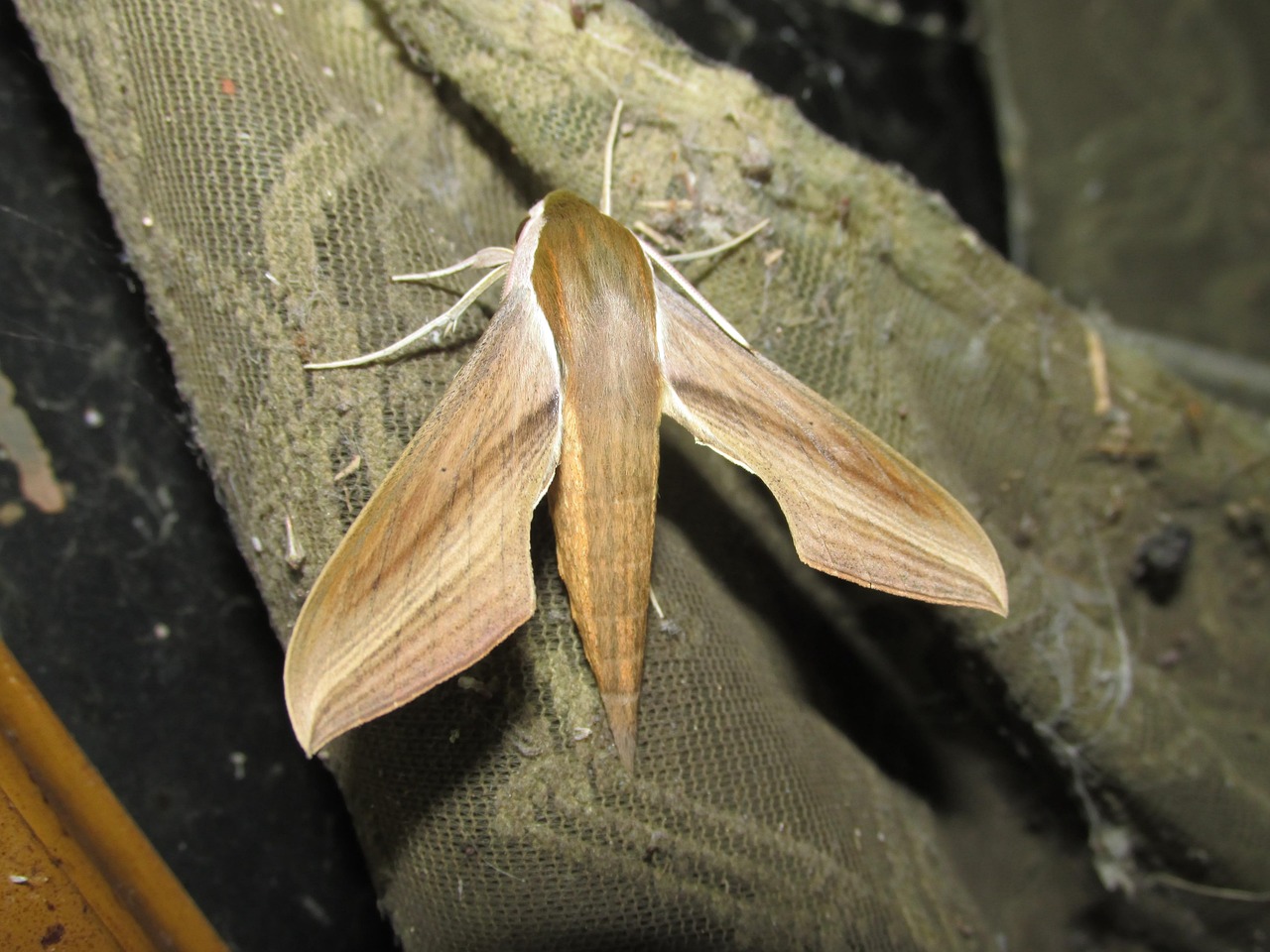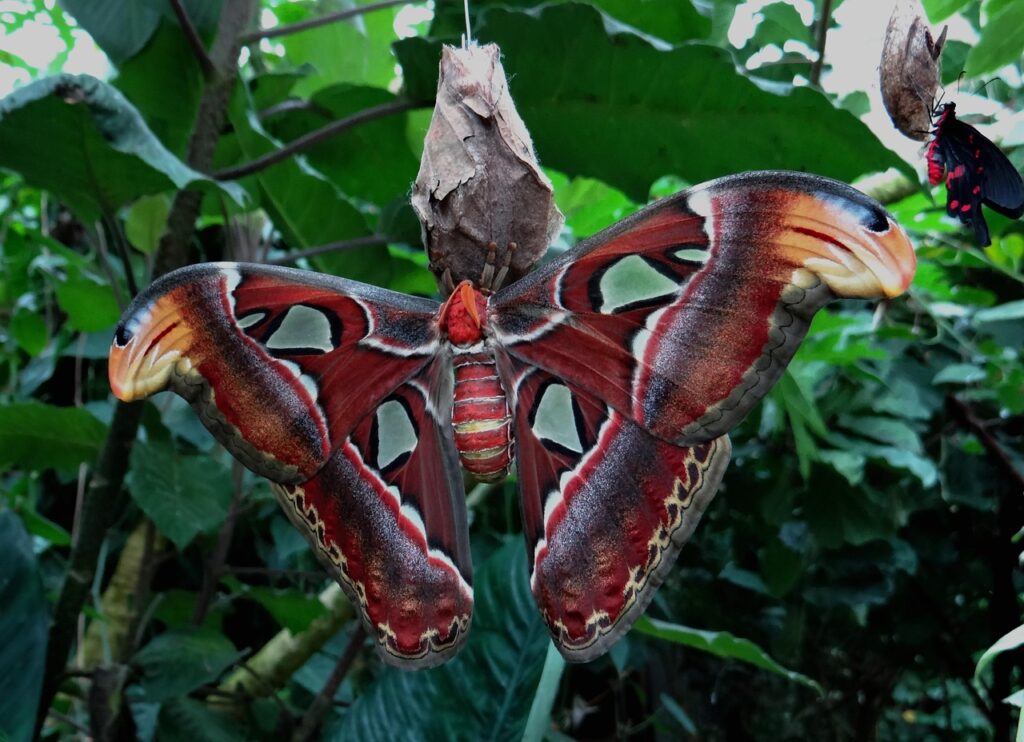Imagine encountering a creature the size of a small bird, with wings spanning nearly a foot across, emerging from the darkness of night. Your first instinct might be to run, especially when those enormous wings create shadows that dance across your porch light. But what if I told you this seemingly terrifying giant is actually one of nature’s most harmless creatures – so harmless, in fact, that it literally cannot eat anything at all?
Meet the Cecropia Moth: North America’s Gentle Giant
The Cecropia moth stands as North America’s largest native moth species, and encountering one feels like stumbling upon a living piece of art. These magnificent creatures can reach wingspans of up to 6 inches, making them easily mistakable for small birds when they flutter past your window at night. Their wings display intricate patterns of red, orange, and white bands set against a backdrop of deep brown and gray, creating a natural masterpiece that seems almost too beautiful to be real.
Despite their intimidating size, Cecropia moths belong to the Saturniidae family, commonly known as giant silk moths. Their scientific name, Hyalophora cecropia, pays homage to their silky heritage and impressive stature. These moths have captivated naturalists and casual observers alike for generations, not just because of their size, but because of their mysterious and brief adult lives.
The Shocking Truth: A Life Without Food

Here’s where things get truly mind-blowing: adult Cecropia moths don’t have functional mouthparts. They literally cannot eat, drink, or consume anything during their adult stage. This isn’t a design flaw – it’s an incredible evolutionary adaptation that seems to defy everything we think we know about survival.
The absence of a mouth means these giants must rely entirely on the energy they stored as caterpillars. Think of it like a biological trust fund – they spend their larval stage accumulating enough resources to fuel their entire adult existence. This energy must sustain them through finding a mate, reproducing, and completing their life cycle, all without taking in a single calorie.
Why Evolution Chose This Extreme Strategy
You might wonder why evolution would create such an extreme survival strategy, but there’s brilliant logic behind this seemingly harsh design. By eliminating the need to feed, adult Cecropia moths can dedicate 100% of their energy and time to reproduction. They don’t waste precious hours searching for food or risk exposure to predators while feeding.
This approach also means they can emerge as adults during specific windows when mating conditions are optimal, rather than being tied to food availability. It’s like nature’s version of a sprint versus a marathon – they go all-out for a short, intense period rather than pacing themselves for a longer journey. This strategy has proven so successful that many giant silk moths have adopted similar approaches.
The Incredible Transformation Journey

The path to becoming a mouthless giant begins with tiny eggs laid on specific host plants. Female Cecropia moths carefully select trees like maple, birch, or wild cherry, instinctively knowing which plants will provide the best nutrition for their offspring. These pinhead-sized eggs contain the genetic blueprint for one of nature’s most remarkable transformations.
Once hatched, the caterpillars embark on an eating marathon that would make competitive food enthusiasts jealous. They can increase their body weight by thousands of times, methodically devouring leaves and storing every possible nutrient. These caterpillars molt several times, each stage revealing more impressive size and increasingly elaborate spiky projections that make them look like tiny dragons.
The Art of Cocoon Construction

When winter approaches, Cecropia caterpillars demonstrate engineering skills that would impress any architect. They construct tough, weather-resistant cocoons attached to tree branches, creating protective shelters that must withstand months of harsh weather. These cocoons aren’t just simple silk wrappings – they’re sophisticated structures with multiple layers and strategic placement.
The caterpillar spins its cocoon using silk that’s incredibly strong and durable, often choosing locations that provide natural camouflage and protection from wind. Inside this fortress, the caterpillar undergoes one of nature’s most extraordinary processes, completely reorganizing its body structure from a leaf-eating machine into a flying reproduction specialist.
Emerging into a Race Against Time

When spring arrives and temperatures warm, the adult moth faces its greatest challenge: emerging from the cocoon and finding a mate before its energy reserves run out. The emergence process itself is exhausting, requiring significant energy just to break free from the protective casing and pump fluid into their massive wings.
Once emerged, males immediately begin searching for females using their incredibly sensitive antennae, which can detect pheromones from miles away. Females, meanwhile, focus their energy on releasing these chemical signals and preparing for egg-laying. Every moment counts in this biological sprint toward reproduction.
The Mystery of Navigation Without Feeding
How does a creature navigate and find mates across vast distances without the ability to refuel? Cecropia moths rely on a combination of chemical communication and remarkable sensory abilities that seem almost supernatural. Males can detect female pheromones at concentrations so low they’re almost unimaginable – we’re talking about a few molecules among billions.
Their antennae work like biological radar systems, constantly sampling air currents and following scent trails that lead them to potential mates. This system is so precise that males can track females over several miles, adjusting their flight paths based on minute changes in chemical concentrations. It’s like following an invisible highway system written in molecular code.
Surviving Predators as a Giant Target

Being massive and unable to eat creates unique survival challenges that smaller, more agile insects don’t face. Cecropia moths have developed several strategies to avoid becoming easy meals for birds, bats, and other predators. Their wings feature eye-spots and patterns that can startle or confuse attackers, buying precious seconds for escape.
They also rely heavily on timing, emerging and flying primarily at night when many visual predators are less active. Their flight patterns include erratic movements and sudden directional changes that make them difficult targets. Some researchers believe their large size actually works as a deterrent, making potential predators hesitate before attacking such an imposing creature.
The Chemical Romance of Pheromone Communication
The love life of Cecropia moths reads like a science fiction novel, built entirely around chemical communication systems that operate with incredible precision. Females release complex pheromone cocktails that serve as both attraction signals and species identification markers, ensuring they only attract the right type of male.
These chemical messages carry information about the female’s location, readiness to mate, and even her genetic fitness. Males respond by following these invisible trails with single-minded determination, sometimes flying for hours or even days to reach the source. It’s a high-stakes chemical conversation where the future of the species literally hangs in the balance.
Mating Rituals of the Gentle Giants

When male and female Cecropia moths finally meet, their mating process reflects the urgency of their limited adult lives. Unlike insects that court for extended periods, these giants get straight to business, understanding instinctively that time is their most precious resource. The mating process can last several hours, during which both partners remain vulnerable to predators.
After mating, females immediately begin searching for suitable egg-laying sites, evaluating potential host plants with the same urgency that drove the male’s search for a mate. They must balance the need to find optimal conditions for their offspring against their rapidly depleting energy reserves, making critical decisions that will determine the success of the next generation.
The Legacy of Motherhood Without Meals
Female Cecropia moths face the ultimate biological challenge: producing hundreds of eggs while operating on a fixed energy budget with no possibility of refueling. Each egg represents a significant investment of stored resources, carefully allocated to maximize the chances of successful offspring development.
The precision required for this process is staggering – females must assess host plant quality, environmental conditions, and predator risks while managing their energy expenditure down to the last calorie. They often scatter their eggs across multiple locations, hedging their bets against localized threats or environmental changes that might affect survival rates.
Winter Warriors: Surviving Months in Suspended Animation

Perhaps the most remarkable aspect of the Cecropia moth’s life cycle is how the pupae survive entire winters in their cocoons, enduring months of freezing temperatures, snow, and ice storms. These cocoons function like biological time capsules, protecting the developing moth while maintaining just enough metabolic activity to prevent death.
The pupae enter a state called diapause, essentially pausing their development until environmental conditions trigger the final transformation. This process requires incredibly precise timing – emerge too early, and they face deadly cold; too late, and they miss optimal mating conditions. It’s a biological gamble that has been fine-tuned over millions of years.
Conservation Challenges for Mouthless Giants

Despite their impressive adaptations, Cecropia moth populations have declined significantly in many areas, facing threats that their evolutionary strategies never prepared them for. Habitat loss, light pollution, and pesticide use create challenges that these ancient survival methods cannot address.
Light pollution particularly affects these night-flying giants, disrupting their navigation systems and exhausting their limited energy reserves as they spiral around artificial lights instead of searching for mates. Urban development removes the native trees their caterpillars depend on, while pesticides eliminate both the moths and their food sources. Conservation efforts focus on creating moth-friendly habitats and reducing light pollution in critical areas.
What We Can Learn from Living Without Excess
The Cecropia moth’s approach to adult life offers profound lessons about efficiency, focus, and making the most of limited resources. In a world where we often assume more consumption equals better survival, these giants demonstrate that sometimes less truly is more. Their strategy of investing heavily in preparation rather than ongoing consumption challenges our assumptions about what it takes to succeed.
Their brief adult lives, lasting only a few weeks, remind us that impact isn’t measured in duration but in purpose and effectiveness. These moths accomplish their primary life goals – reproduction and species continuation – with remarkable efficiency, dedicating every available resource toward ensuring the next generation’s success.
The next time you encounter one of these magnificent creatures near your porch light, remember that you’re witnessing one of nature’s most extraordinary survival strategies in action. That seemingly terrifying giant floating through the darkness is actually engaged in a desperate race against time, powered by nothing more than the memories of meals consumed months earlier as a caterpillar. What other assumptions about survival and success might nature’s incredible adaptations challenge in our own lives?

